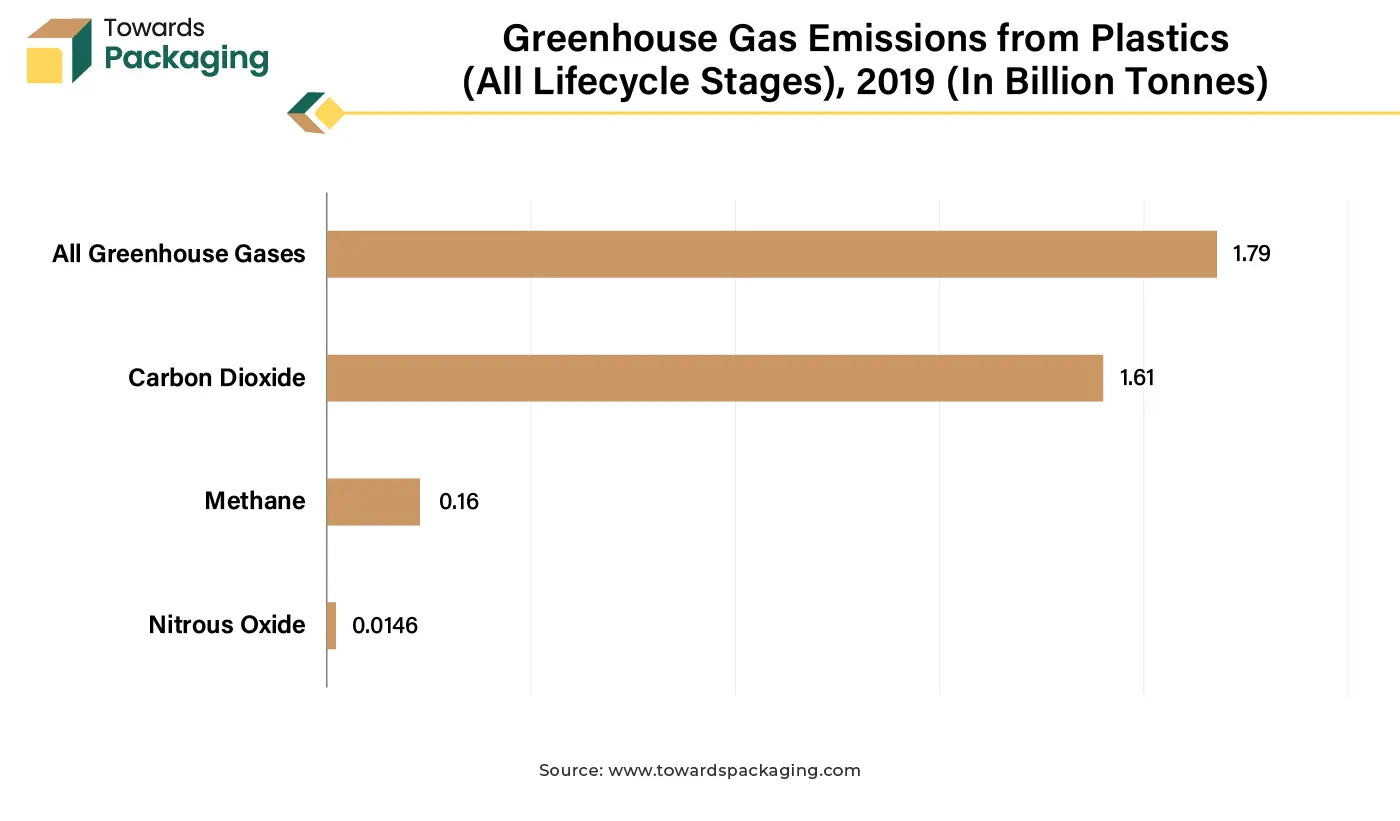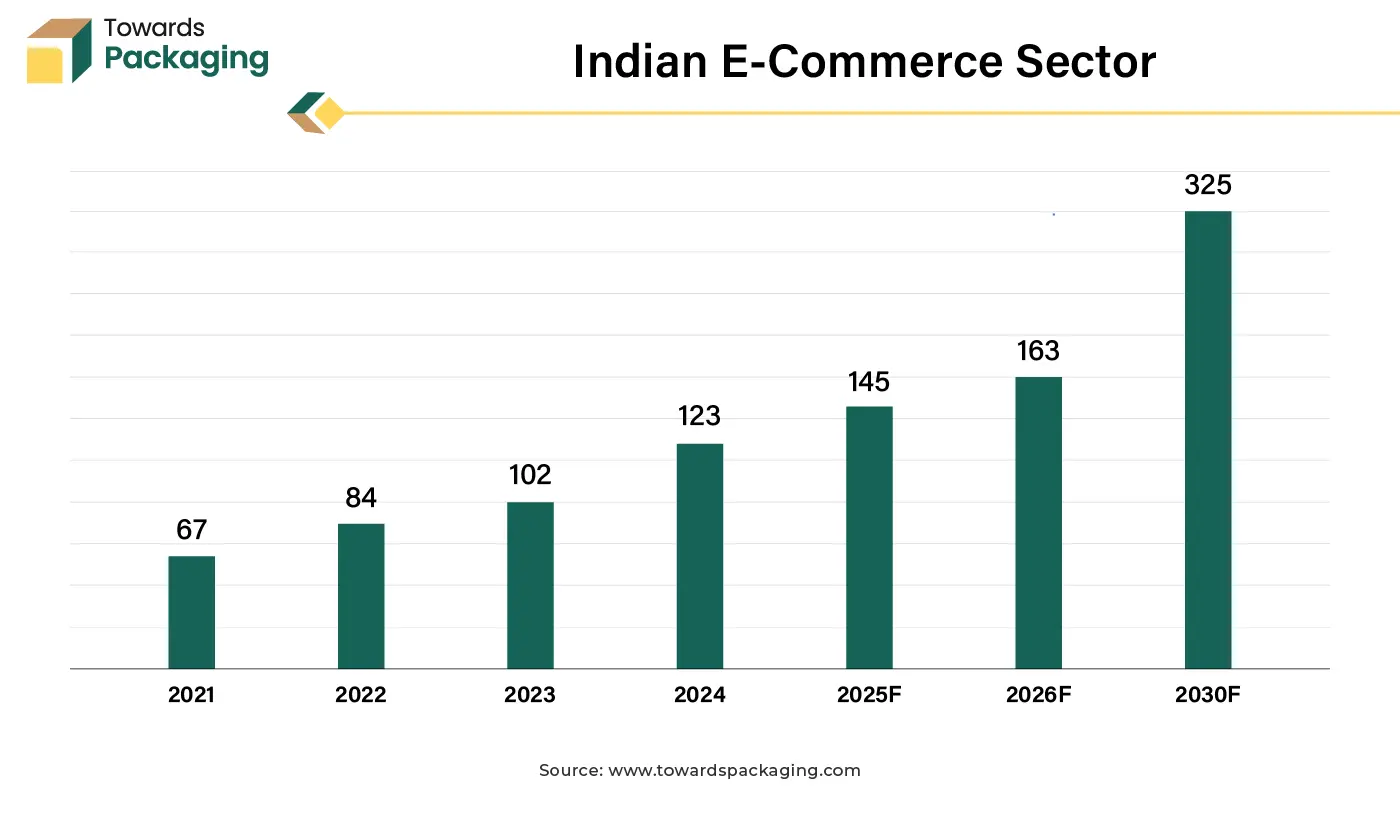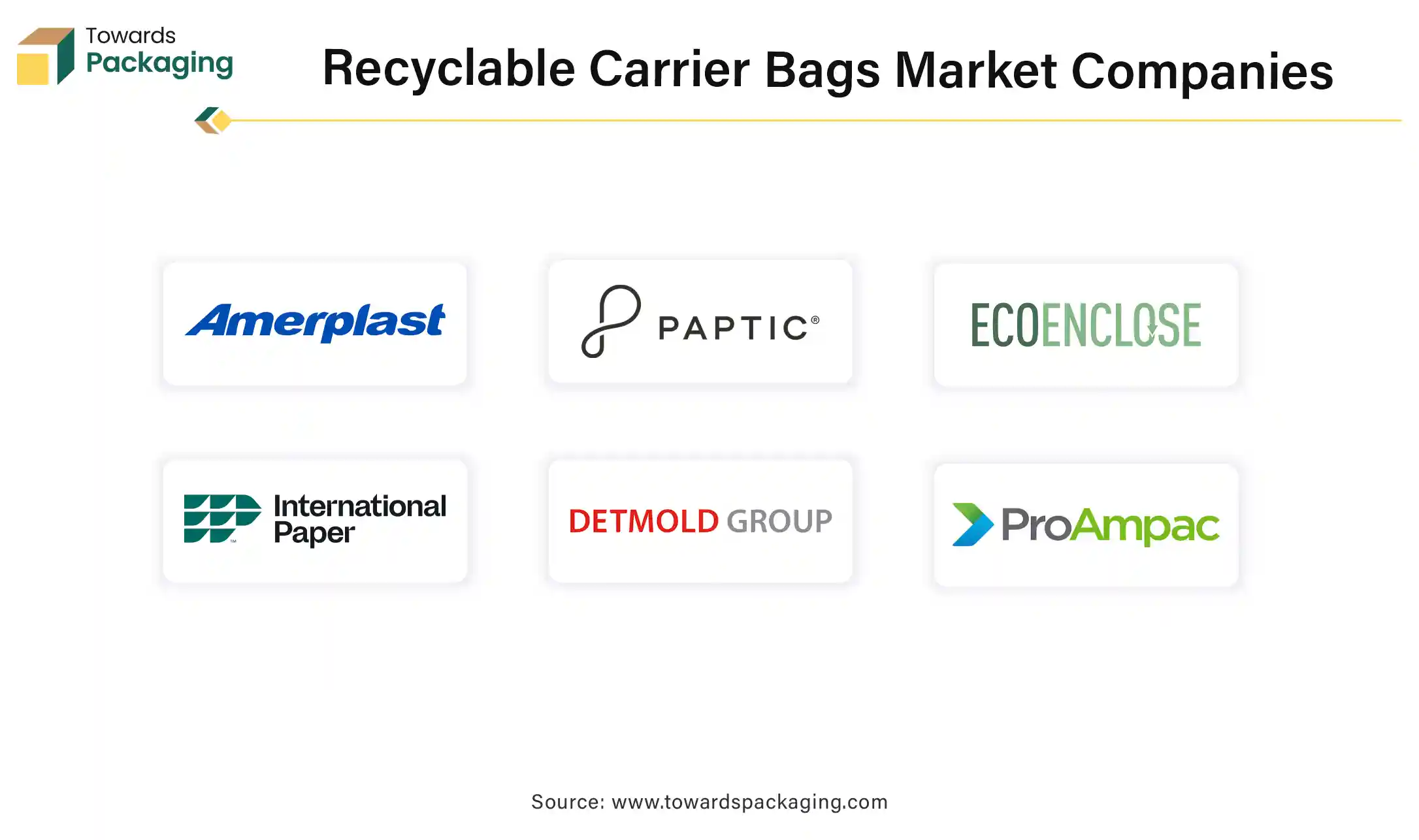April 2025
The recyclable carrier bags market is experiencing a boom, with revenue expected to soar into the hundreds of millions from 2025 to 2034. This rapid expansion is fueled by the growing shift toward sustainable and eco-friendly packaging solutions, as both consumers and businesses prioritize environmental responsibility.
The recyclable carrier bags market is predicted to witness strong growth in the years to come. Recyclable carrier bags are eco-friendly alternatives that are made to be recycled at the end of their lifecycle. They are made-up of the materials such as paper, cotton and jute, among others and help in reducing the waste as well as minimize environmental impact. They are used in retail, grocery and commercial sectors as part of the global efforts to combat the growing plastic pollution. Many governments as well as industries are currently promoting recyclable products through regulations and incentives that help consumers to adopt sustainable shopping habits. With the advancements in the material science, these bags are becoming durable, cost-effective and versatile, which is further likely to support its adoption worldwide.
The rising environmental awareness and concerns over plastic pollution along with the stringent government regulations and bans on single-use plastics in various countries is expected to augment the growth of the recyclable carrier bags market during the forecast period. Furthermore, advancements in the biodegradable and recycled materials as well as the corporate sustainability initiatives are also anticipated to augment the growth of the market. Additionally, the increasing consumer preferences for the eco-conscious products and the ethical shopping habits coupled with the growing retail and e-commerce sectors as well as the increasing disposable incomes is also projected to contribute to the growth of the market in the near future.
The growing environmental concerns due to the increasing plastic pollution and as well as the climate change is anticipated to support the growth of the recyclable carrier bags market during the estimated timeframe. Single-use plastic bags have long been a major contributor to environmental degradation. Studies have shown that millions of plastic bags end up in oceans and waterways each year, breaking down into microplastics that disrupt ecosystems and enter the food chain.
Plastic waste will nearly triple from 353 million tons in 2019 to 1,014 million tons in 2060, as per the Organization for Economic Co-operation and Development (OECD). Approximately two-thirds of the plastic waste in 2060 will come from short-lived applications such packaging, consumer goods and clothing. Non-OECD nations will produce a substantial quantity of plastic waste (65%), specifically in developing nations across Asia and Africa, where plastic waste is expected to increase at the fastest rates.

Furthermore, plastics results in the greenhouse gas emissions throughout their whole lifecycle, and this trend is projected to persist in the lack of new regulations. The lifecycle of plastics was responsible for 1.8 gigatonnes of atmospheric carbon dioxide equivalents (Gt CO2e) of greenhouse gas emissions in 2020; by 2060, this amount is predicted to nearly double to 4.3 Gt CO2e. This growing issue has motivated individuals, corporations as well as the governments to look for eco-friendly alternatives.
Additionally, consumers are also becoming aware of the environmental impact of their purchasing decisions and this is causing a shift in their shopping patterns. Nowadays, a lot of people actively search for recyclable bags because they understand how important they are for minimizing waste and saving resources. Thus, the growing awareness and concerns is likely to increase the demand the recyclable carrier bags during the forecast period.
The durability concerns as well as consumer behavior are likely to impede the growth of the recyclable carrier bags market during the estimated timeframe. Some eco-friendly materials such as paper, lack the strength and moisture resistance of conventional plastic bags. Paper bags are not strong enough to last even for three uses, and as they rip easily, they rarely last one usage most of the times. One would need more of them because they are heavy and not quite as sturdy as plastic bags, and they fully lose their rigidity when wet. While paper bags are known for their environmental benefits, they may tear quickly with high loads or when exposed to moisture, hence making them unsuitable for carrying groceries, liquids and bulky objects. This restriction hinders some of the consumers along with the retailers from completely shifting away from plastic, as they demand bags that can go through regular usage in a variety of situations.
Furthermore, in spite of the increasing awareness of the environmental issues, a sizable proportion of the consumers continue to use single-use plastic bags due to their lightweight nature, low cost and simplicity of use. Plastic bags are commonly accessible at most retail outlets and frequently given for free, thus making them an attractive choice for buyers who value convenience over long-term environmental benefits.
Additionally, another biggest challenge is the habit-driven nature of the shopping behavior. Many people forget to bring their bags and instead rely on the readily available plastic alternatives. Also, some people think that eco-friendly bags like cotton bags are heavy to carry. The choices made by consumers are also influenced by cost. Although recyclable bags save money over time, the upfront cost may stop some customers, specifically in the price-sensitive markets.
The government regulations and bans on the plastic bags are expected to create substantial opportunity for the growth of the recyclable carrier bags market in the near future. Many countries are finally recognizing the environmental risks caused by single-use plastics, prompting stringent laws aimed at minimizing plastic waste. These regulations consist of outright bans, taxation on plastic bags as well as mandates for organizations to adopt sustainable alternatives. For instance
In September 2024, a bill was signed in California that restricts grocery retailers from using any kind of plastic shopping bag. The state lawmakers approved a new bill that will outlaw all plastic shopping bags beginning in 2026. Customers will now only be asked whether they would like a paper bag if they don't bring their own. The environmental group Environment America Research & Policy Center reports that 12 states, which include California, already have some form of state ban on plastic bags.
Colombia has banned the production, importation, exportation, marketing, and distribution of goods made-up of single-use plastics from 2022. Plastic holders and swabs will be prohibited starting in January 2026, while plastic bags and cutlery is prohibited starting from January 2025. Certain single-use plastics, such as those utilized in processed, animal and wet meals, medical procedures, and health care operations, are excluded from the regulations and bans.
The First Act to Amend the Packaging Act went into effect in Germany in February 2021. Beginning on January 1, 2022, the amendment prohibits the distributing of thin plastic bags at the place where sales of products are made. Plastic bags that have walls thinner than 50 microns are considered thin and light. The EU Plastic Bags Directive's criteria are implemented by the German Packaging Act modification. For disobeying the ban, merchants risk fines of up to 100,000 euros, or over US$120,555.
Such initiatives have considerably increased the need for recyclable bags in a variety of sectors. Subsidies, tax breaks and grants for sustainable materials all help contribute to the market growth. As more countries adopt new regulations, the need for recyclable carrying bags is likely to rise, providing considerable potential for manufacturers and merchants globally.
Artificial Intelligence (AI) is expected to have a substantial impact on the recyclable carrier bags market. It helps in improving the decision-making throughout the value chain as well as in transforming the procedures. Predictive maintenance and AI automation in manufacturing reduces downtime and production costs and this makes the production of the bags scalable. Furthermore, AI-powered robotics increases the accuracy in the bag assembly, folding and cutting, resulting in better quality and less material waste.
Additionally, AI aids in the research and development through evaluating novel, sustainable materials more quickly and precisely than with conventional techniques and simulating material qualities. This speeds up the development of robust and environmentally friendly carrying bags. AI is also helping to design alternate fibers and biodegradable polymers that increase sustainability without sacrificing strength.
Advanced data analytics and machine learning algorithms are also utilized to predict consumer demand, providing vendors and manufacturers to closely match inventory levels with market trends. AI based packaging options are emerging, which use sensors to deliver real-time data on bag consumption and recycling rates, supporting responsible consumer behavior. Predictive analytics can also help improve resource allocation, minimizing energy use and waste. Retailers use AI analytics to improve design marketing campaigns and supply recyclable bags to environmentally aware customers, hence increasing consumer engagement and increasing revenue. AI based recommendation engines promote sustainable bag alternatives for online shoppers, thereby promoting adoption. AI integration not only improves the operational efficiency and reduces costs, but it also supports innovation in product development and sustainability practices, improving the market's shift toward a circular economy.
The paper bags segment held considerable share in the year 2023. Papers are now one of the world’s most versatile and commonly utilized materials. Paper bags are completely reusable and biodegradable, which makes them sustainable. Recycled fibers from paper bags can be used to make new bags or other paper goods. Paper bags are also more sustainable because they may be reused many times before being recycled. Majority of the companies have already made the switch to paper bags with handles as single-use plastic bags rapidly lose popularity with the general public. The fact that paper bags promote air circulation is one of its most beneficial features. This is essential for preserving the products' freshness. Furthermore, compared to plastic, custom-printed bags present a better packaging option. For example, printing on paper is easier than printing on the plastic and this facilitates in customization for companies as well as consumers.
The retail & supermarkets segment held substantial share in the year 2023. With substantial transaction volumes and frequent interactions, these venues are specifically positioned to influence and shift consumer behavior toward sustainable practices. Supermarkets have adopted recyclable alternatives to suit the new regulations and satisfy consumers due to the regulatory demands as well as environmental concerns forcing shops to phase out the single-use plastics. Furthermore, the huge distribution networks of retail chains promote economies of scale and this makes the transition to sustainable packaging both financially and logistically feasible. Additionally, supermarkets gain from the marketing benefit of supporting green projects, which improves their brand recognition and attracts a wider range of customers. Their efforts to normalize recyclable bags through broad use and visible environmental campaigns strengthen consumer trust. This is further expected to support the segmental growth of the market in the near future.
Asia Pacific is likely to grow at a fastest CAGR during the forecast period. This is due to the presence of the strong manufacturing base as well as the rapid urbanization across various economies of the region. Additionally, the growing retail and e-commerce sectors are also expected to contribute to the regional growth of the market. According to the data by the India Brand Equity Foundation, by 2030, the Indian e-commerce market is expected to have grown significantly to reach a value of US$325 billion. During the 2024 holiday season, India's e-commerce industry generated almost US$ 14 billion in Gross Merchandise Value (GMV), a 12% increase over the year before. Also, the online grocery market in India is predicted to grow at a 33% compound annual growth rate (CAGR) to reach US$ 26.93 billion in 2027. Furthermore, the economic growth and rising disposable incomes is likely to contribute to the regional growth of the market.

North America held considerable market share in the year 2023. This is due to the policies at state and municipal levels along with the increasing federal attention to sustainability in the region. For instance, in New York State, single-use plastic carryout bags are prohibited, with few exceptions. DEC could take legal action against anybody who delivers plastic carryout bags to clients who are required to collect taxes. Any anyone who breaches any of the provisions of ECL § 27-2803, which include the restriction on plastic carryout bags, and is obligated to collect taxes shall be issued a warning letter for the first infringement. Additionally, the growing environmental consciousness among the consumers is also further expected to contribute to the regional growth of the market. Also, the corporate sustainability initiatives are further expected to support the regional growth of the market.

By Material
By End-User
By Distribution Channel
By Region
April 2025
April 2025
April 2025
March 2025